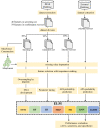A hyperaldosteronism subtypes predictive model using ensemble learning
- PMID: 36810868
- PMCID: PMC9943838
- DOI: 10.1038/s41598-023-29653-2
A hyperaldosteronism subtypes predictive model using ensemble learning
Abstract
This study aimed to develop a machine-learning algorithm to diagnose aldosterone-producing adenoma (APA) for predicting APA probabilities. A retrospective cross-sectional analysis of the Japan Rare/Intractable Adrenal Diseases Study dataset was performed using the nationwide PA registry in Japan comprised of 41 centers. Patients treated between January 2006 and December 2019 were included. Forty-six features at screening and 13 features at confirmatory test were used for model development to calculate APA probability. Seven machine-learning programs were combined to develop the ensemble-learning model (ELM), which was externally validated. The strongest predictive factors for APA were serum potassium (s-K) at first visit, s-K after medication, plasma aldosterone concentration, aldosterone-to-renin ratio, and potassium supplementation dose. The average performance of the screening model had an AUC of 0.899; the confirmatory test model had an AUC of 0.913. In the external validation, the AUC was 0.964 in the screening model using an APA probability of 0.17. The clinical findings at screening predicted the diagnosis of APA with high accuracy. This novel algorithm can support the PA practice in primary care settings and prevent potentially curable APA patients from falling outside the PA diagnostic flowchart.
© 2023. The Author(s).
Conflict of interest statement
The authors declare no competing interests.
Figures




References
Publication types
MeSH terms
Substances
LinkOut - more resources
Full Text Sources
Medical

